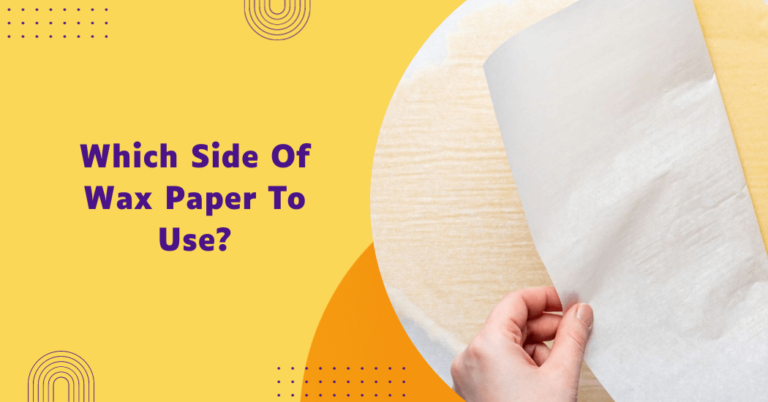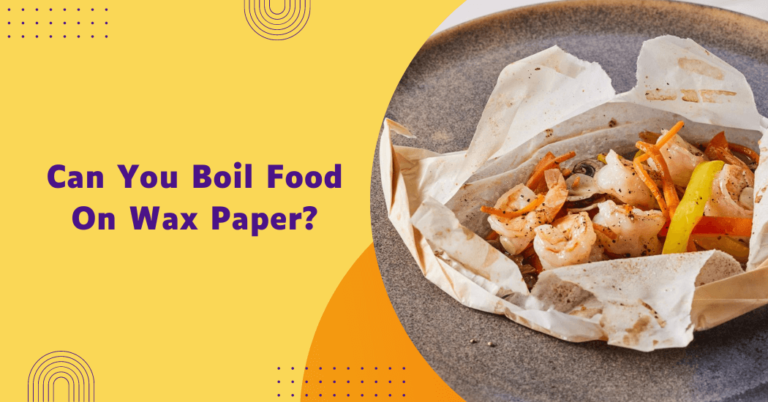Is Wax Paper Compostable, Recyclable & Biodegradable?
In recent years, the growing concern for environmental sustainability has led individuals, businesses and governments to seek eco-friendly alternatives to everyday products and packaging materials.
One such material that has garnered attention is wax paper, a versatile and commonly used food wrapping and storage option. However, as the push for greener practices gains momentum, questions have arisen regarding the environmental impact of wax paper.
In this blog post, we will dive into whether the wax paper is compostable, recyclable or biodegradable and the truth may surprise you!
So stick around as we unravel the mysteries of this popular kitchen item and provide some helpful guidance on how to dispose of your wax paper in an environmentally-friendly manner.
Is wax paper compostable?
Yes, wax paper is compostable under the right conditions. Composting wax paper involves placing it in a compost pile where it can decompose naturally over time. However, it’s important to bear in mind that not all types of wax paper behave the same way when composted.
Wax paper coated with paraffin, a petroleum by-product, might not be the best choice for compost due to potential toxin release.
On the other hand, wax paper coated with soybean or beeswax is more environmentally friendly and compostable. Therefore, when choosing wax paper with composting in mind, it’s essential to verify the type of wax used in its production.
What makes wax paper compostable or not compostable?
Compostability is determined by whether a material can decompose naturally and safely within a reasonable timeframe, turning it into nutrient-rich compost that can be used to enrich the soil.
Key factors that make wax paper compostable:
- Biodegradable wax: The wax used in compostable wax paper is biodegradable and can be broken down by microorganisms in a compost pile.
- Organic paper: The paper component is organic and comes from plant fibers, making it suitable for decomposition in a composting environment.
- Non-toxic ingredients: Compostable wax paper is typically made from non-toxic and food-safe ingredients that won’t harm the composting process or the resulting compost.
- Proper conditions: Composting requires the right balance of moisture, oxygen and temperature. Compostable wax paper should be exposed to these conditions to break down effectively.
Key factors that make wax paper non-compostable:
- Synthetic or petroleum-based wax: If the wax used in the paper is derived from synthetic or petroleum-based sources, it may not break down in a composting environment.
- Additives or coatings: Some wax paper products may have additional coatings or additives that hinder decomposition.
- Slow breakdown: Non-compostable wax paper may take a long time to degrade, if at all, leading to accumulation in the compost pile.
When considering whether wax paper is compostable or not, it’s important to check the packaging or label for information about the materials used.
Is wax paper recyclable?
Unfortunately, wax paper is not recyclable. The waxy coating of the paper makes it difficult to be reprocessed in a recycling facility and can contaminate other materials if mixed with them. As such, wax paper should always be disposed of in a landfill or composting bin rather than added to your regular recycling collection.
Challenges in recycling wax paper
Recycling wax paper poses a number of challenges due to its unique composition and usage:
- Mixed material composition: Wax paper is composed of both paper and wax, two materials that require different processes for recycling. This mixed composition makes it difficult to recycle wax paper as it cannot be treated as pure paper waste.
- Contamination from food residues: Wax paper used for food wrapping and storage often has remnants of food. These food residues can cause contamination during the recycling process, leading to poor-quality recycled products or even rendering the recycling process ineffective.
- Lack of proper recycling infrastructure: There is a lack of infrastructure required to separate and break down the mixed materials in wax paper for recycling. Most recycling centers are not equipped to handle wax paper, thus it often ends up in landfills.
Recycling process for wax paper
Despite the challenges, there are specific processes that can be used to recycle wax paper:
- Deinking and pulping: In this process, the paper portion of wax paper is separated from the wax. The paper is then soaked in a mixture of water and chemicals which dissolves the ink and breaks down the paper into a pulp, thus removing the wax.
- Separation techniques: Advanced separation techniques, such as flotation and washing, are used to separate the wax from the paper pulp. This is a challenging step because it requires specific equipment and expertise.
Consumer responsibility in promoting wax paper recycling
As consumers, we have a responsibility to promote the recycling of wax paper. This can include choosing wax paper products that are recyclable, using them in a manner that minimizes contamination and understanding local recycling guidelines to ensure proper disposal.
By making conscious choices and promoting education about wax paper recycling, we can help to create a more sustainable future.
Is wax paper biodegradable?
Wax paper is not always biodegradable due to the potential presence of a plastic coating known as polyethylene. While the wax component of the paper is biodegradable, the polyethylene coating can hinder breakdown in soil and water.
To ensure proper disposal, it’s advisable to treat wax paper as non-biodegradable and discard it as regular waste. If the composition of your specific wax paper is unclear, erring on the side of caution is recommended.
Wax paper is ultimately compostable under the right conditions and should not be recycled due to its waxy coating. It is important to confirm the material used for coating before composting as some of them may contain toxins or be non-biodegradable.
Factors affecting biodegradation of wax paper
The biodegradation of wax paper depends on several factors:
- Type of wax: The type of wax used in the coating can significantly impact the rate and extent of biodegradation. Natural waxes such as soy and beeswax decompose more readily than synthetic or petroleum-based waxes, which may resist degradation.
- Composting conditions: For successful biodegradation, the right balance of moisture, oxygen and temperature is essential. These conditions ensure that the microorganisms responsible for decomposition can thrive and break down the material.
- Exposure time: The duration for which wax paper is exposed to composting conditions can also affect its biodegradability. Prolonged exposure can aid in the decomposition of more resistant components such as certain types of wax.
- Presence of microorganisms: The presence and diversity of microorganisms in the composting environment are crucial. Different microorganisms can break down different materials, so a diverse microbial community can enhance the biodegradation process.
- Paper composition: The type and quality of paper used in wax paper can influence the rate of biodegradation. Higher-quality organic papers may degrade more readily than lower-quality papers or those treated with certain chemicals.
Understanding these factors can help in making informed decisions about the disposal and potential composting of wax paper, promoting more sustainable waste management practices.
Also Read: Is Wax Paper Edible & Can You Eat Wax Paper?
Benefits of using compostable, recyclable and biodegradable materials
Opting for compostable, recyclable and biodegradable materials can yield numerous environmental benefits, contributing substantially to sustainable living practices.
- Reduced landfill waste: The use of these materials can significantly diminish the volume of waste that ends up in landfills. By composting or recycling, most organic waste can be effectively reused, reducing the amount of garbage disposed of in landfills.
- Resource conservation: Recycling allows materials to be reused, saving on the raw materials and energy that would be required to produce new products from scratch. This can conserve precious natural resources such as wood, water and minerals.
- Decreased carbon footprint: Composting organic waste like food scraps and yard waste can reduce methane emissions from landfills. Methane is a potent greenhouse gas that contributes to climate change.
- Soil enrichment: Compostable materials decay into nutrient-rich compost that can enhance soil fertility, promoting the growth of plants and reducing the need for chemical fertilizers.
- Sustainability awareness: The use of these materials can help raise awareness about waste management and sustainability, encouraging more responsible consumption patterns and promoting a more eco-conscious society.
By embracing compostable, recyclable and biodegradable materials, we can make significant strides toward a more sustainable and environmentally friendly future.
Wrap Up
In conclusion, the composability, recyclability and biodegradability of wax paper can vary depending on its specific composition and the recycling and composting facilities available in your area.
While wax paper is generally considered biodegradable and compostable due to its natural materials, the presence of wax coatings and additives may affect its breakdown process. It’s important to check with local waste management authorities to determine whether a wax paper can be composted or recycled in your region.
When disposed of properly, wax paper has the potential to contribute to more environmentally friendly waste management practices but ensuring its proper treatment remains a crucial step in minimizing its impact on the environment.






